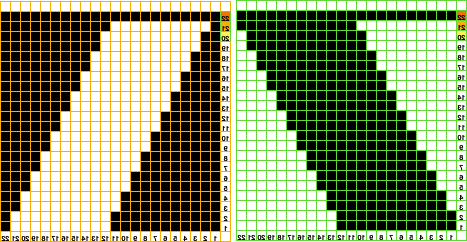This is another fabric combining holding and slip stitch to create shapes. Below is my first working repeat, the colored lines indicate a dividing line that would give me a black square on either side for setting up the second, split repeat to reverse the direction of the knit stitches.
I am sharing not to provide a pattern or specific how-to, but to provide some ideas for technique experimentation by readers with some experience and familiarity with the combined use of patterning and holding.
 My mylar repeat as used on the 910 appears in the direction as drawn on the knit side, while punchcard models using suitable width repeats knit repeats in the direction as drawn on the purl side. Later electronics automatically mirror programmed repeats, true of my later model 930. Depending on the model in use this electronic repeat may require mirroring before or after downloading.
My mylar repeat as used on the 910 appears in the direction as drawn on the knit side, while punchcard models using suitable width repeats knit repeats in the direction as drawn on the purl side. Later electronics automatically mirror programmed repeats, true of my later model 930. Depending on the model in use this electronic repeat may require mirroring before or after downloading.  A newer chart of the design, with row numbers requiring actions highlighted on the left of each repeat.
A newer chart of the design, with row numbers requiring actions highlighted on the left of each repeat.  Machines that automatically mirror would be selecting this
Machines that automatically mirror would be selecting this  Air knitting is a good way to test pattern placement on the needle bed prior to any knitting.
Air knitting is a good way to test pattern placement on the needle bed prior to any knitting.
When the slip stitch setting is used and segments are worked on only part of the needle bed or with needles out of work, end needle selection is usually canceled. On electronic machines, this is done using the KCII cam setting.
Each 22-row program is used across one full row of “entrelacs”.
The bottom repeat as given above preselects KCII <–, knits left to right, and the top repeat preselects KCII->, knits right to left on the 910.
Each horizontal segment knits on groups of 22 stitches and ends on “half” a repeat.
The half repeats combined with the reversal of the knit direction result in a balanced fabric.
As the direction is reversed, the alternate repeat needs to be programmed. A bit on method:
COR for bottom mylar repeat KCII <- knit all stitches color A,
COL set the machine to slip <->, bring all but the first 22 sts on the left to hold, and knit 20 rows.
The resulting shape is being created from left to right when the top is reached the stitches at the left of the sequence will be in the B position, and the ones on the right will be in work.
COL: at this point push the next 22 sts into work, knit to the right.
COR: return first repeat 22 sts to hold position, and continue in pattern for 21 rows.
COL: bring the next group into work, and knit/move across the selected number of needles.
COR: bring the previous grouping of 22 out to hold. Repeat as needed for the desired width.
When the full row of shapes is completed and the last group of needles is preselected, COR: cancel holding and slip, knit one row on all stitches to the opposite side, and change color to B if desired.
COL: program subsequent repeat, KCII, select ->.
COR: set cam buttons to slip <->, KC to hold, bring all but the first 22 needles on right into work, and reverse the full sequence.
My swatch was worked on needles 34L to 21R and had an interesting 3D texture until I pressed it.
The differences in the size of the eyelets at the tops and bottoms of the shapes are due to the fact that when stitches are brought out to hold on the carriage side, an automatic wrap is created, reducing the size of the small slits usually formed in short row knitting.
I like to press the initial studies to have a clearer definition of the edges of the resulting shapes and the location of color changes so as not to disrupt the pattern.  There will be yarn ends to be dealt with where color changes occur, some could be knit in with the same color while making the piece. I can imagine that if the 2 rows of all knit stitches are eliminated between entrelac rows, even more variations could be done with added colors, but I personally am not “going there”.
There will be yarn ends to be dealt with where color changes occur, some could be knit in with the same color while making the piece. I can imagine that if the 2 rows of all knit stitches are eliminated between entrelac rows, even more variations could be done with added colors, but I personally am not “going there”.